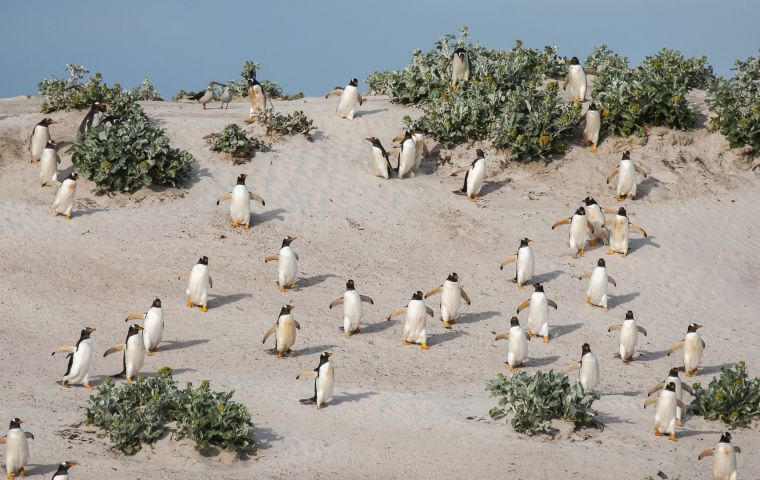MercoPress. South Atlantic News Agency
Falklands first look at over 30 years of seabird monitoring results
 Monitoring gentoo penguin breeding populations in the 1990s would have been worrying with almost year-on-year declines
Monitoring gentoo penguin breeding populations in the 1990s would have been worrying with almost year-on-year declines The Falkland Islands are frequently associated with globally significant seabird populations. Indeed, the inshore waters of the Islands have not long been designated as a Key Biodiversity Area (KBA) for this very reason. Understandably stated as a reason for national pride, tourism, conservation and research benefits,
Amongst others, we should remember that this is not an unalterable fact. The seabird populations that support the economy and which are a vital part of our highly productive marine and coastal ecosystems (through nutrient distribution), could grow, decline or even, worst-case, disappear.
The Falkland Islands Seabird Monitoring Programme (FISMP) has been running for just over 30 years, surveying a number of the Islands’ important seabird populations for conservation assessments, but also as measures of the health of the marine environment.
Programs such as this are difficult to maintain and require investment, but like most good wines they improve and increase in value with age. Information on the here and now is useful, but equally, if not more, important for decision-making is how this compares with where we were, and where we are likely to be heading.
The same is true of seabird populations. Monitoring gentoo penguin breeding populations in the 1990s would have been worrying with almost year-on-year declines, whilst doing so in the 2000s would have given cause for optimism, until the crash of 2015.
Comparing information over a few years is commonplace, in part because most studies only have access to such short-term data, but it may not tell the whole story.
Longer-term data instead allows us to step back and look at the bigger picture. For the first time, this year’s FISMP report presents all the data on the Program species. The results provide a better context by which to interpret monitored seabird trends over the last few decades.
The FISMP data indicates that for breeding populations of gentoo and southern rockhopper, repeating cycles of increase and decrease have occurred, not simply from one year to the next but over periods of 10-15 years. For longer-lived and slower-maturing species like black-browed albatross and southern giant petrel - which have also been monitored over shorter timescales – cycles, if they exist, have not become apparent, but they may yet.
Monitoring shows that decline in seabird species in the Falklands such as penguins is not in itself an immediate cause for concern – populations have gone down and come back up again more than once. It is a simple rule of nature that not all species can increase all of the time. What is important in maintaining healthy populations is the ability of species to recover as part of these fluctuating cycles.
Whilst we are lucky that current data for FISMP species indicate generally stable or positive overall trends in breeding numbers, the long-term consistent decline in the breeding success of southern rockhopper over the monitoring period is a significant concern and may point to challenges ahead.
The current climate crisis has brought new, human-induced environmental pressures to bear on species, ecosystems and their population cycles, and is likely - probably more than any other factor - to influence the Falkland Islands’ seabird populations and ecosystems in the future. Many seabird species are already exposed to threats, some like albatross and penguins are some of the most threatened species globally.
A small change in survival rates in a long-lived bird like albatross can be the difference between population growth and decline, and we are seeing increasing evidence of the effects of climatic influences on seabird populations here. More extreme conditions or increasing frequency of pressures such as El Niño events could be the straw that breaks the camel’s back.
The future of our globally important seabirds will depend on their resilience to the climate crisis and our responsibility as part of aiding that resilience is to reduce, not increase, pressures on the ecosystems on which they depend.
A huge thanks to all those involved in the FISMP through land access, logistics, and fieldwork and to FIG for funding. The report is available for download from https://falklandsconservation.com/downloads/ (Penguin News)




Top Comments
Disclaimer & comment rulesCommenting for this story is now closed.
If you have a Facebook account, become a fan and comment on our Facebook Page!